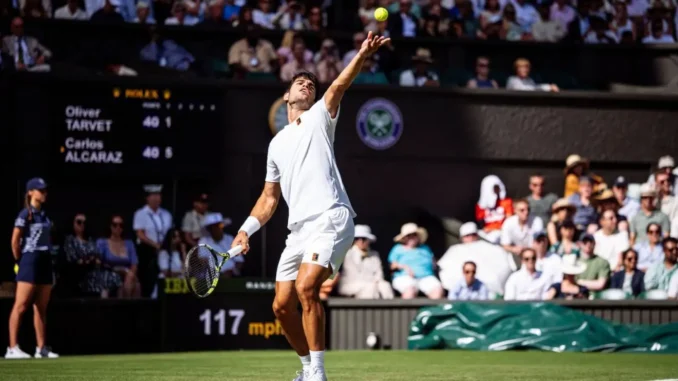
Under the scorching sun of Wimbledon 2025, where temperatures soared to a record 31°C, Carlos Alcaraz has solidified his status as a grass-court maestro. The two-time defending champion, fresh off a French Open title and a commanding Queen’s Club victory, breezed into the third round with a 6-1, 6-4, 6-4 triumph over British qualifier Oliver Tarvet on July 2. Yet, beneath the brilliance of his 20-match winning streak and a historic record-breaking 30 consecutive victories across Wimbledon and Roland Garros, a persistent challenge lingers: his serve. “I think here in Wimbledon, I’m struggling a little bit with the serve,” Alcaraz admitted after his second-round win, pinpointing the shot he believes is “probably the most important shot” on grass.
Alcaraz’s second-round performance was a marked improvement from his opening match, a grueling five-set battle against Fabio Fognini that exposed his serving vulnerabilities. Against the Italian veteran, his first-serve percentage dipped to a troubling 58%, and he won just 52% of second-serve points, allowing Fognini to apply relentless pressure. “After the first round, I left the court not happy at all with the performance with the serve,” he confessed. The numbers told a stark story: Alcaraz lost serve five times in that four-and-a-half-hour marathon, a rare lapse for a player whose 90.9% grass-court win rate is the highest in the Open Era among those with at least 20 matches. Determined to address this flaw, he brought coach Samuel Lopez into his team before the 2025 season, tweaking his serving motion to enhance accuracy and consistency.
Against Tarvet, Alcaraz showed signs of progress. His first-serve percentage climbed to 65%, and he won 69% of first-serve points, nearly matching his 70% against Fognini. “Today I felt a bit better,” he noted, though he remained candid about the work ahead. “I’m feeling really different between Queen’s and here with the balls, with the speed. So I’m struggling a little bit, but I’m just getting more confident.” His groundstrokes, lauded for their explosive power and precision, overwhelmed Tarvet, with six breaks of serve—two per set—securing a straight-sets victory. Yet, Tarvet’s 11 break points against him underscored that Alcaraz’s serve remains a target, even against a world No. 733. “A lot can’t improve without the serve,” Alcaraz emphasized, signaling his focus for practice. “Tomorrow I’m going to pay much attention on the serve. Let’s see if in the third round I’ll be better.”
The importance of the serve on grass cannot be overstated. With Wimbledon’s slick surfaces amplifying the shot’s impact, Alcaraz’s pursuit of a third consecutive title—matching Björn Borg’s rare feat—hinges on this key area. His grass-court dominance, driven by lightning-fast footwork and a 32.56% first-serve return points won rate (the best among active players), has masked serving inconsistencies in the past. At Queen’s, he averaged 12 aces per match, with half his first serves going unreturned, hinting at his potential to become a “serve bot.” Yet, Wimbledon’s unique conditions, from heavier balls to faster courts, have disrupted his rhythm. “I’ve been practising really well and playing really well, but Wimbledon is different. I could feel the difference,” he said after the Fognini match.
Alcaraz’s candor reflects his maturity. His 9-0 record against younger players and a 15-1 five-set Grand Slam record showcase a champion’s resilience, but he knows perfection is elusive without a reliable serve. “I knew at the beginning I had to be really focused, had to play my best tennis,” he said of facing Tarvet, whom he praised effusively: “I just love his game to be honest. The level he played in the first match on Centre Court, which I know is really difficult, he showed great tennis.” As he prepares for a third-round clash with either Felix Auger-Aliassime or Jan-Lennard Struff, Alcaraz’s focus is clear. Toni Nadal, Rafael’s former coach, declared, “I sincerely believe that, under normal conditions, very few opponents have the ability to trouble Carlos.” Yet, with seeds like Alexander Zverev and Holger Rune falling early, the draw is open, and Alcaraz’s serve could be the difference between history and heartbreak.
As Wimbledon 2025 unfolds, Alcaraz’s journey is a thrilling narrative of a young titan battling to refine his craft. With his infectious joy—“I found the right way to try and enjoy after every match”—and unmatched court coverage, he remains the man to beat. But the serve, that “most important shot,” is his crucible. If he can harness it, the All England Club may indeed hand him the trophy early, as some jested after his Queen’s dominance. For now, Alcaraz’s gaze is fixed on practice, where every serve is a step toward Wimbledon immortality.
Leave a Reply